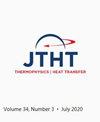化学反应边界层流动膜系数近似的数值研究
IF 1.7
4区 工程技术
Q4 ENGINEERING, MECHANICAL
引用次数: 1
摘要
航天器进入行星的气动热分析在很大程度上依赖于传统的工程模型。本文研究的膜系数传热模型估计了地球大气中层流、解离、化学反应边界层对飞行器的对流加热。该模型需要给定轨迹点的车辆和流场信息,并估计焓势和对流热通量之间的比例关系。实际上,气动热工程师必须决定哪些假设适合他/她的应用。这项工作着眼于对任意轴对称飞行器的大量CFD模拟,以分析在壁面边界施加的质量和能量约束的相对重要性,以及各种扩散模型的影响。在测试的能量边界条件子集中,发现最理想的能量边界条件是辐射平衡边界条件,该边界条件允许对流热通量的保守估计,但也产生沿表面的流场相关的空间热分布。其他主要发现是为了使整个行业的设计工程师都能很容易地使用薄膜系数工程模型。本文章由计算机程序翻译,如有差异,请以英文原文为准。
Numerical Investigation of Film Coefficient Approximation for Chemically Reacting Boundary-Layer Flows
Aerothermal analysis of spacecraft planetary entry is heavily dependent on heritage engineering models. The film coefficient heat transfer model examined in this paper estimates the convective heating to the vehicle for a laminar, dissociated, chemically reacting boundary layer for an Earth atmosphere. This model requires information about the vehicle and flowfield for a given trajectory point and estimates a proportional relationship between enthalpy potential and convective heat flux. In practice it is the aerothermal engineer who must decide which assumptions are appropriate for his/her application. This work looks at numerous CFD simulations for an arbitrary, axisymmetric flight vehicle to analyze the relative importance of both the mass and energy constraints imposed at the wall boundary, as well as the effect of various diffusion models. Within the subset of tested energy boundary conditions, it is found that the most desirable energy boundary condition is the radiative equilibrium boundary condition, which permits conservative estimates of convective heat flux, but also generates flowfield-dependent spatial thermal distributions along the surface. Other key findings are presented in an effort to make the film coefficient engineering model readily available to design engineers across industry.
求助全文
通过发布文献求助,成功后即可免费获取论文全文。
去求助
来源期刊

Journal of Thermophysics and Heat Transfer
工程技术-工程:机械
CiteScore
3.50
自引率
19.00%
发文量
95
审稿时长
3 months
期刊介绍:
This Journal is devoted to the advancement of the science and technology of thermophysics and heat transfer through the dissemination of original research papers disclosing new technical knowledge and exploratory developments and applications based on new knowledge. The Journal publishes qualified papers that deal with the properties and mechanisms involved in thermal energy transfer and storage in gases, liquids, and solids or combinations thereof. These studies include aerothermodynamics; conductive, convective, radiative, and multiphase modes of heat transfer; micro- and nano-scale heat transfer; nonintrusive diagnostics; numerical and experimental techniques; plasma excitation and flow interactions; thermal systems; and thermophysical properties. Papers that review recent research developments in any of the prior topics are also solicited.
 求助内容:
求助内容: 应助结果提醒方式:
应助结果提醒方式:


